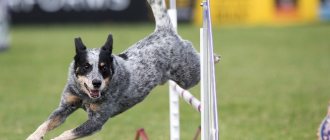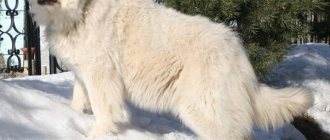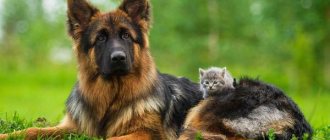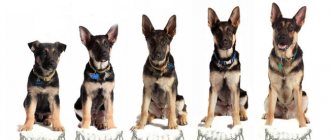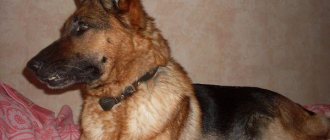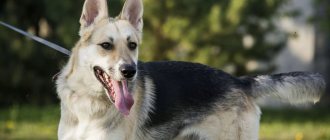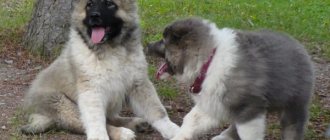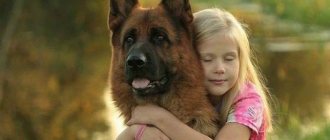Brief historical background
The homeland of the English Shepherd is the United States of America, where this breed, considered native American, developed. Legend has it that the distant ancestors of these dogs were brought to the British Isles by Roman legionnaires, where they assimilated by crossing with local herding dogs, and then were used for many centuries to herd cattle.
The American part of the chronicle dates back to the 17th century, when the first European settlers arrived in America, taking with them dogs (probably of British origin) to guard and protect property. Further, these individuals mixed with other foreign breeds (French Beauceron, Sheltie, Collie, etc.), as well as aboriginal hunting dogs. In 1927, the United Kennel Club (UKC) registered the British Shepherd as a separate breed, and the first standard requirements were developed at the same time. The latest current standard is dated May 1, 2021 .
The international canine community currently does not recognize English Shepherds.
Advantages and disadvantages
English women have a whole set of undeniable advantages. Their flexible character, resourceful mind, unquestioning obedience and devotion make them truly loyal friends for humans. The disadvantages include only one property - some representatives of the breed are capable of carrying a defective gene, due to which they have increased sensitivity to medications. Also, due to their mobility, such dogs sometimes suffer from hip dysplasia.
Related article: Origin and description of the Australian Shepherd
Description of the English Shepherd
The British Shepherd has proven itself to be a truly universal and multifunctional working breed, which not only performs herding duties, but is also used to guard private property, as a guide for blind and visually impaired people, as well as in service in the police, army and for various rescue operations.
Breed standard
The English Shepherd is a lean, agile, harmoniously built, medium-sized dog with strong massive bones and a well-developed muscular corset. The body is elongated with a powerful straight back, a deep, voluminous sternum reaching to the elbows, a long strong loin and a slightly tucked belly line.
The English Shepherd is a not very large dog, but beautifully and harmoniously built
Breed characteristics:
- Medium-sized, slightly angular, dryish head with a rounded, wide skull and an elongated cone-shaped muzzle, set on a slightly curved, muscular neck. Stop moderate.
- Narrow jaws in a regular scissor bite. The lips are tightly closed.
- Small almond-shaped eyes have a medium set (neither far nor close). The iris is dark brown. The look is smart and lively.
- Small, triangular, drooping ears are located high, hanging on cartilage.
- A free-hanging tail of medium length, the tip curved.
- The limbs are long, parallel, well developed with rounded pads and fingers gathered into a dense ball.
- Height at the withers: for bitches - 46–56 cm (preferably 48–51 cm);
- for males - 48–58 cm (preferably 51–53 cm).
- in females - 18–23 kg;
The Englishwoman moves easily and smoothly, if necessary, instantly changing the direction of movement without effort or body roll.
The coat is thick, of medium length with a densely packed undercoat. The guard hair is often straight, but can be wavy and even curly. There is a mane on the neck, feathers on the legs, and a thick plumb on the tail. The head, ears, and the front of the legs are covered with smooth and short hair.
The following colors are acceptable:
- tricolor (white, black and tan);
- black and tan;
- white-red;
- black and white;
- white and sable.
Most often, English Shepherds have a tri-color color.
The reasons for disqualification will be:
- cryptorchidism (unilateral and bilateral);
- shyness or anger;
- albinism;
- non-standard colors (full white, merle, full red, white markings more than 1/3 of the body).
Nutrition
Dogs of the English Shepherd breed are fed according to the general nutrition plan, selecting the diet according to the age limit. Owners who prefer dry food choose a super premium or premium diet for active breeds. The amount of feed is given in accordance with the age table recommended by feed developers and located on the back of each bag.
For those who prefer to feed their pet natural food, it should be remembered that the diet must not only be qualitatively balanced, but also intended for a predator. Therefore, the diet of an English Shepherd should include meat and offal - liver, heart, stomach, lung.
Meat trimmings of beef, veal, lamb origin, but in no way pork. Multivitamins, beneficial elements and the Omega-3, 6, 9 complex, fish and cottage cheese must be present .
Character of the breed
Like all herding breeds, the British Shepherd has a calm and balanced character . She is smart, quick-witted and quite capable of making decisions on her own. She is infinitely devoted to her owners, does not like to be alone, always trying to be close to people. He reacts warily to strangers, without visible aggression, but if necessary, he will quickly respond, rushing to defense.
He treats children with care and tenderness, never even allowing himself to snap, but subject to good upbringing and timely socialization. The dog is very loyal to other pets, seeing them as creatures of lower rank, and constantly tries to bring everyone into the flock, biting the lower part of the legs (a shepherd). The guarding instinct of this herding breed is excellently developed; shepherd dogs always try to keep their controlled territory in sight, instantly reacting to violations of boundaries with a loud bark.
English Shepherds are very patient with children.
English Shepherds are distinguished by the useful ability to skillfully climb trees in pursuit of game (squirrels, birds, etc.).
In fact, dogs never climb high, especially large ones. But one day I observed a very gifted male dog, who knows how, got into our yard when the bitch was in heat. When he saw me, he did not attack or show any aggression, he rushed headlong towards the fence (openwork, welded from a metal rod) more than two meters high and literally flew up it, clinging with his paws, like a real rock climber, jumped off and ran away.
Training
The issue of training the English Shepherd deserves special attention. Despite its gentle disposition, the dog needs regular training and long walks. It is advisable to walk it in an open, deserted area so that the dog can run around to its heart’s content.
The breed has excellent muscles that require significant physical activity. If you want, you can raise a champion. Training at equipped dog parks gives dogs pleasure; the pets are grateful to the owner for such productive leisure time. Without good runs, the dog feels sluggish.
From the age of six months they begin training. The dog will learn standard commands quickly; obedience is in his blood. Complex commands will require the owner’s patience, for which he will be fully rewarded. Don’t forget to encourage your pet; thanks to treats, the animal perceives learning faster.
From the moment the animal appears in the house, have toys. Three is enough. Even adult shepherds do not miss the opportunity to play with toys from childhood. You shouldn't offend a dog; they have a good memory. An animal will never respect a person who beat a dog.
Choosing a puppy and its cost
Finding a purebred English Shepherd puppy in our country and even in Europe is almost impossible, since the breed is not very common in its historical homeland. On this issue you will have to contact American breeders. Approximately, the dog can cost the future owner from 800 to 1 thousand dollars (excluding transportation costs).
Occasional advertisements from private individuals for the sale of a purebred British dog should be ignored, since this breed can easily be passed off as an ordinary mongrel. The baby will be cute, but he will not have any unique breed qualities.
It is very difficult to acquire a purebred English Shepherd puppy
Price and where to buy
Choosing a puppy is not an easy task, since this breed is not very common in Russia. However, you can find a kennel (Flying Spitz, Linus Julius) and buy an animal there. Sometimes you can buy a puppy secondhand; it will cost much less, but there will be no guarantee of the dog’s purebredness and good health.
When choosing a puppy, you need to pay attention to the eyes, fur and bite of the teeth, and look at the parents. Your baby should not smell like ammonia or feces. It is advisable that he has the necessary documents. Otherwise, you need to ask what vaccinations were done and when. The price of a puppy in a kennel can reach 50,000 rubles. The cost depends on the pedigree. It is important to choose suitable nicknames. The following are suitable for males: Akbar, Baron, Count, etc. Suitable nicknames for girls are Alpha, Gerda, Frida, etc.
It is better to have an English Shepherd in a private house, not an apartment. Moreover, this dog is suitable only for active people who always have free time.
Features of care
English Shepherds are very easy to care for.
Hygiene
Standard set of hygiene procedures:
- comb the fur a couple of times a week using a strong comb and a slicker brush (more often when shedding);
- bathe no more than 1-2 times a year, using pet shampoos for long-haired animals;
- eyes and ears should be examined and cleaned weekly with cotton pads or wipes soaked in veterinary lotion;
- Brush your teeth at least once every 7-10 days with a special brush and toothpaste for animals that does not require rinsing;
- trim the nails with a nail clipper once a month if they do not grind down on their own.
Walk
Even a shepherd dog kept outside needs to be regularly walked for an hour or more so that it can run around to its heart's content and satisfy all its motor needs. You need to walk twice a day (morning and evening), keeping the dog busy with active games, and not just walking sedately along the paths.
It is recommended to get an English Shepherd for people leading an active lifestyle who can provide their pet with the proper level of physical activity (take it with them on bike rides, morning jogging, mountain hiking, etc.).
Shepherds need a lot of exercise
Nutrition
Owners of working dogs usually prefer to feed their dogs freshly prepared homemade food, for the preparation of which they use:
- raw lean meat (veal, rabbit, horse meat, etc.);
- offal (trimming, tripe, heart, lungs, etc.);
- vegetable oil (unrefined);
- eggs;
- cereals (rolled oats, rice, yachku, etc.);
- fermented milk products with reduced fat content (cottage cheese, kefir, etc.);
- sea fish;
- seasonal vegetables and fruits, herbs, berries;
- multivitamin and mineral supplements.
It is forbidden to feed shepherd dogs fatty, spicy, sweet, fried, smoked and spicy foods, as well as legumes and tubular bones.
Freeze-dried factory formulas for feeding Englishwomen are also suitable, but you need to choose high-quality food of at least premium class (Royal Canin, Brit, Akana, etc.), designed specifically for active dogs. Adults are fed twice a day, puppies from 3 to 6 times (depending on age).
Nicknames and names
If the dog was purchased from a kennel, it is accompanied by a package of documents, including the puppy - a birth certificate. The registration document must include the puppy's name, information about the parents and their pedigree numbers. The veterinary passport contains information about the puppy's vaccination.
But in addition to the official nickname, you can give the dog a pet name. It will not appear either at the exhibition or in other documentation in the name of the dog, but no one disputes the right to assign a pet name.
You can use the Internet, or the history of Britain with many sonorous names known throughout the world. This could be the name of a fantasy or historical hero, a television idol. The main thing is that it is consonant, easy to pronounce and the dog likes it.
Health
There is no reliable data on the health status of English Shepherds and their susceptibility to any diseases . This shepherd dog can live for about 13–15 years. Throughout her life, it is imperative to fight skin parasites using various means of protection (drops, sprays, collars, etc.), vaccinate annually and worm her once every 6-8 months.
It can be assumed that these shepherd dogs, being a working breed and having gone through natural selection for many generations, do not have serious health problems.
Interesting Facts
- These shepherds are able to surprise with a rare feature - they move through trees. In the middle of the last century, advertising brochures were published in the USA, where this extraordinary dog was depicted climbing a tree after some animal. At the bottom there was a caption: “An English Shepherd will get anything and anyone even from a tree.”
- In Russia and the countries of the former CIS, the English Shepherd appeared towards the end of the 90s of the last century, but has not yet achieved great popularity. It is not included in the RKF classification. However, a suitable nursery can be found. For example, in Moscow, Kyiv and Minsk.
- These dogs are allergic to medications for a reason. Recent research at Washington State University has shown that 15% of all English Shepherds may have a disorder in the MDR1 (membrane protein, glycoprotein) gene. This results in an inappropriate response to some medications used to treat dogs. The consequence may be impaired movement, coordination, trembling, vomiting, disorientation, even death of the animal. A simple cheek swab test is required to test for the mutation.
- To better imagine what the character of the English Shepherd is, you can recall the film “Shaggy Christmas Trees”. There, one of the characters, the dog Pirate, is played by a border collie. Loyalty, dedication, affection, ingenuity, endurance - all these qualities were passed on from the “Scots” to their descendants, the English Shepherds.
Training and education of the English Shepherd
Training and raising a British Shepherd is easy. A smart and smart dog understands perfectly what is required of it, and grasps everything on the fly. She remembers commands quickly, but is prone to stubbornness and some independence. The owner will need to show patience and firmness to keep the animal in check. A puppy must be socialized and taught behavioral norms from a very early age.
The English Shepherd can take part in various dog competitions
After 10 months, it is recommended to take a general obedience course (GOC) with your dog.
Security qualities of a shepherd
Dogs of this breed are distinguished by their excellent quality of herding and guarding sheep, poultry, and pigs.
They will cope excellently with the role of a guard in the house and a hunting companion. English shepherds successfully serve in the police, the Ministry of Emergency Situations, can be guide dogs, and are also involved in psychotherapeutic programs (canistherapy).
The English Shepherd is very active and loves long walks.
Content
Caring for a dog does not require any special skills. It is necessary to comb the animal's fur several times a week. Regular grooming will prevent the coat from matting and matting. Although tangles are very rare due to the fairly soft wool.
During the molting period in the transitional periods of the year (spring and autumn), the “English cat” loses quite a lot of fur. Therefore, it is worth brushing more often during these periods. Therefore, you should not keep such a dog in an apartment or house. Otherwise, be prepared for the fact that there will be wool everywhere - on furniture, carpet, clothes.
It is worth giving your pet a separate place to rest; this will also reduce the presence of hair throughout the apartment. You should only bathe your dog when necessary.
The English Shepherd is able to quickly perceive and learn information . This ability makes her a frequent participant in various competitions and exhibitions.
A good quality of this dog is its lack of stubbornness . On the contrary, she is ready to obey a person and obeys him perfectly. Although she has attacks of demonstrative ignoring, especially if the order comes from a person unfamiliar to her.
The dog's nutrition also plays an important role. And, if in nature food is rich in proteins and clean water, then in the city, in the absence of the necessary physical activity, nutrition must play an important role.
General information about herding dogs
Initially, herding dogs were called shepherd dogs, but 200 years later, the International Canine Association divided them into 2 special groups:
- shepherd dogs;
- shepherds
Important! Currently, there are officially more than 10 different breeds of herding dogs.
Taking a look at the herding breeds in alphabetical order, with names and photos, you will notice that most of them are shepherds. Dogs that herd sheep have in common: shaggy hair, endurance, intelligence, attention and a sensitive character.
Character traits
Four-legged shepherds are brave and hardy.
A shepherd dog should not have a hunting instinct. The dog cannot leave the herd to pursue prey, and if the protected animals are in danger, the dog must immediately confront the predator.
Since herds often grazed in the mountains and open fields, herding breeds have long hair and a dense undercoat that protect them from wind and cold. The shepherd dog is intended not only to guard livestock, but also as a pet. He gets along well with the family, becomes a nanny for the kids and is ready to watch them without closing his eyes.
Advantages of herding breeds:
- medium size and nice build;
- well-developed muscles can withstand heavy and prolonged physical activity;
- a thick and beautiful fur coat that can withstand mountain climates;
- not a very developed hunting instinct; when prey appears, the dog does not abandon the herd;
- wariness of strangers;
- sociability;
- devotion to the owner.
The herding dog has a number of positive characteristics, but they also have some disadvantages. They need space and the opportunity to constantly walk. When kept at home, they feel uncomfortable; from lack of activity, they begin to get sick and waste away.
Important! Since these are quite large dogs, they should not be left alone with small children - if they play too much, they can hurt the child.
How to choose a little “Englishman”
Choosing a puppy is a responsible matter. And you need to approach it with all seriousness. When purchasing, it is better to give preference to nurseries or breeders with a good reputation. It is optimal to purchase a dog whose age is from 8 to 10 weeks. During this time, the breeder must resolve all issues with documents and get the necessary vaccinations.
When choosing a puppy, it is important to assess its health status. There should be no discharge in the dog's eyes. The presence of tear tracks may be a sign of ophthalmic diseases. The ears should also be free of discharge and unpleasant odor. If a puppy constantly rubs his hearing organs with his paws or shakes them, this may indicate the presence of diseases.
It's easy to test your puppy's hearing: drop something heavy or loud on the floor and watch the baby's reaction.
It is important to check the condition of the oral cavity. Healthy gums will be pink. And their pallor may indicate the presence of worms or a disease such as anemia.
The puppy's fontanelle (non-ossified area of the skull vault) must be closed at the time of purchase. If this does not happen, then it is possible that the dog has hydrocephalus.
The condition of the skin and coat is also very important to evaluate. The animal's hair should be shiny and clean. And the skin has no signs of peeling or redness.
English Shepherd puppies are very curious and friendly. They are happy to make contact even with a stranger. You should not take a puppy that is too cowardly if you are purchasing a dog for protection. An aggressive puppy can also cause a lot of problems as it grows.
The choice of a puppy must be approached with full responsibility
What to ask the breeder when buying
After examining the litter, you should clarify the following points with the breeder:
- Is there a certificate stating that the puppy’s mother was tested for infection and was vaccinated before breeding?
- Do your parents have genetic diseases or congenital diseases?
- What kind of litter is this and was it planned? Unplanned litters are often not registered, so it will be impossible to obtain a pedigree for the puppy.
- Does the puppy have a veterinary passport indicating vaccinations and antihelminthic measures?
